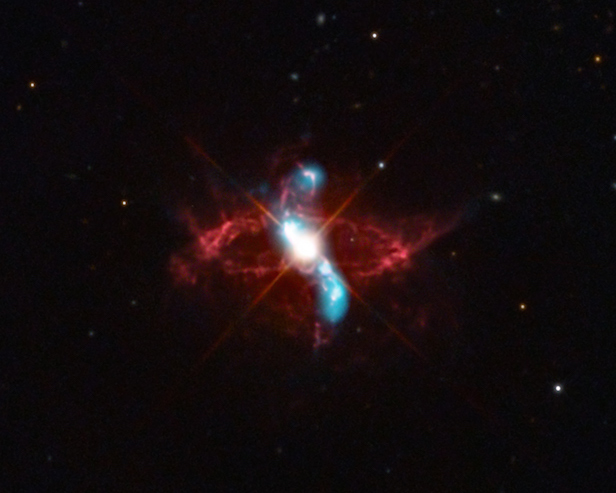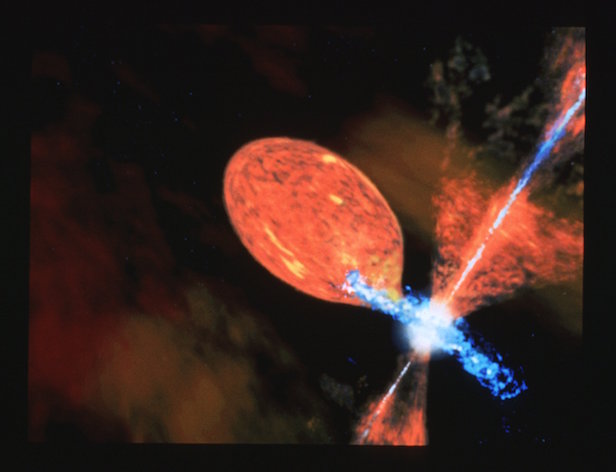Astronomers study volatile stellar eruption dating back almost 1000 years
The explosive behaviour of R Aquarii can tell us about the two stars that comprise the system

Optical data (red) of R Aqr shows the inner ring. The outer ring is about twice as wide as the inner ring, but is too faint to be visible in this image. The Chandra X-ray data (blue) show the shockwaves in 2005. Image credit: X-ray: NASA/CXC/SAO/R. Montez et al.; Optical: Adam Block/Mt. Lemmon SkyCenter/U. Arizona
Starting with a nova explosion in 1073, the star system R Aquarii (R Aqr) has been a star system to study for generations. With recently acquired optical and X-ray data, studying the volatile nature of this “symbiotic” star can help us understand how the stellar pair at the centre interact.
A “symbiotic” star system is a rare binary system, consisting of a luminous white dwarf and a much cooler red, giant star. Just 710 light years away is R Aqr, and in the case of this red giant, it is far from stable as it enters the final stage of its life. The fuel powering the red giant is running scarce, which triggers a large, long brightness fluctuation. With each fluctuation lasting longer than one hundred days, this gives rise to a specific variable star known as a Mira variable.
Due to the Mira variable increasing in size and the white dwarf’s powerful gravity, material for the red giant gets transferred to its companion. When the energetic material has accumulated on the surface of the white dwarf, it will cause an explosion, also known as a nova, blowing away the outer layers in an extravagant fashion. In fact in 1073, there was a nova explosion visible with the naked eye originating from R Aqr, and this nova is believed to be the cause of an outer ring surrounding this binary star system.

This artist impression shows material transferring to the white dwarf, and then expelling jets. Image credit: NASA/ESA/D. Berry
There is also an inner ring of material, which is the red ring visible is the image above, and this is believed to originate from a nova explosion in the 1770s. Since the Chandra X-ray Observatory was launched in 1999, R Aqr has studied in a completely new frequency. In 2000, 2003 and 2005, images revealed X-ray jets shooting from the binary star perpendicular to the rings, and they have changed their shape throughout the years. From these observations, astronomers have been able to deduce that the jets travel between speeds of around 1.4 million and 1.9 million miles per hour.
These jets are not related to the novae explosions, as a team of scientists at the Harvard-Smithsonian Centre of Astrophysics have determined they move at different speeds, this is because the jets are less energetic than the novae explosions. It is only with further close observations, will we know understand how this stellar couple interact fully, sparking such lively events. With that being said, another jet is possibly on its way, by using the Chandra data, astronomers predict another jet to appear within the next ten years. As for another nova explosion, if it continues with its supposed periodic explosion, which previously happened in 1073 and 1773, the next one won’t happen until the 2470s.
Keep up to date with the latest space news in All About Space – available every month for just £4.99. Alternatively you can subscribe here for a fraction of the price!




